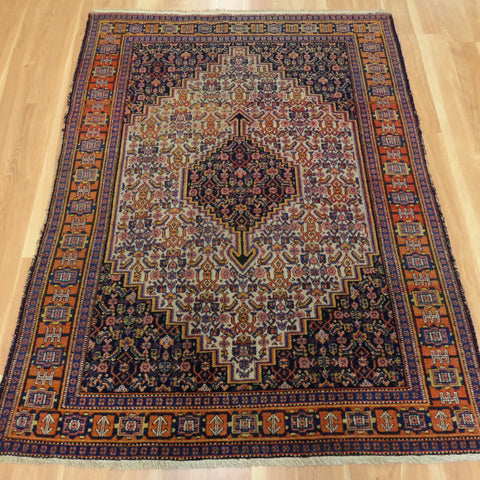Types of Persian Rugs
Abadeh rugs feature designs very similar to Shiraz rugs, but can usually be distinguished by their cotton fringe ends. With designs inspired by Qashqai rugs, Abadehs generally feature tribal designs in red, blue and ivory colors schemes. Read more about Abadehs.
Typically featuring Tribal designs, Afshar rugs usually utilize red, rust, blue, brown, and ivory colors. They are woven by the Afshar tribe in Southeastern Iran. Older Afshars are typically smaller in size while more modern copies of this rug come in larger sizes. Read more about Afshars.
Bakshaish Rugs
Similar to Heriz rugs and Sultanabads, Bakshaish carpets often come in room-sizes and may feature a single medallion, all-over patterns such as the Herati, or geometricized designs.



Birjand Rugs

Chenar Rugs
Often featuring a single row of stepped diamond-shaped medallions, Chenar rugs are also usually classified as Hamedan rugs.


Ferahan Rugs
Vintage Ferahan rugs represent some of the best constructed Iranian carpets with curvilinear designs and often featuring stylized floral motifs.
Gabbeh Rugs
With wide borders and abstract designs highlighted with a bold color palette, Gabbeh rugs usually feature relatively basic patterns when compared to their Persian counterparts. Thick pile and a low knot count are typically found in Gabbeh rugs.
Gorevan Rugs
Named after a small village in the district of Heriz, Gorevans are a type of coarsely woven Heriz rug with a specific design.



Isphahan Rugs
Makers of what might be thought of as the quintessential Persian carpet, Isphahan weavers have been long known to produce sophisticated and refined pieces of art. Fine and sturdy, Isphahan rugs are desired among designers and collectors alike.





Kazvin Rugs

Also spelled Gazvin, Kazvin rugs come in all sizes but are most commonly found in room-sizes. Red, Blue and Ivory colors are typical. Soft wool is used for the pile and knots are usually tightly woven on cotton foundations. These rugs are usually thick and heavy.
Kerman rugs are named after their place of origin: the city of Kerman Iran. Ravar Kirmans, a special type of Kerman rug are highly desirable due to their rarity. Kerman rugs are usually wool woven on cotton foundations with fine weaves and may include floral motifs, curvilinear styling, and/or elaborate pictorial scenes.
Kermanshah Rugs
Khamseh rugs are tribal rugs woven in Southern Iran by members of the Khamseh federation. Blues, Ivory, and Browns are commonly used in Khamseh rugs.Khorassan Rugs
Kolyai Rugs
A wide variety of rugs are woven in the Kurdistan villages of Iran. Generally they feature all wool materials, although some may also have goat hair or camel hair accents. Newer Senneh rugs have cotton foundations. Both Sennehs and Bidjars are woven in this area. Designs are typically tribal with no specific pattern, some may have a single medallion, multiple medallions or an all-over pattern.
Lilihan rugs closely resemble Sarouks, although they are slightly more pliable. They normally feature wool woven on cotton foundations with tones of red, pink and blue. Floral designs are typical although other curvilinear arabesque patterns like the one pictured above can also be found.
Luri Rug
Mashad Rug
Maslaghan rugs, nicknamed by their lightning bolt design feature sharp medallions often with red, orange and blue color schemes. Some of these rugs are also referred to as Melayers.
Mehraban Rug
Melayer rugs are woven in the Hamedan province of Iran and feature tightly woven knots in the single-wefted Hamedan weave. All-over patterns are common in Melayers, these rugs come in a variety of sizes from small to very large.
Mosul Rug
Muskabad Rug
Nain rugs are very similar in design to Isphahan rugs although it was not until the 1930's that Nains came onto the market. Blues, Creams and Ivorys make up the color schemes while materials usually consist of wool woven on cotton foundations.
Nahavand Rug
Qashqai Rug
Qum Rug
Rudbar Rug
Sarouk Rugs are known for their striking color palettes of reds, roses and blues paired with intricate floral patterns. Most easily identified by the blue cotton weft used in the foundation, these rugs are usually strong and dense.
Saveh Rug
Senneh rugs are known for their tight weaves with a soft and silky pile and a rough feeling backside. Rich, dark colors with all-over and medallion patterns are popular in Sennehs.
Serab Rug
Serabend Rug
Serapi Rug
Shiraz rugs are known for their bold colors and tribal designs. Woven in Southwest Iran, Shiraz rugs typically have wool pile on wool foundation.
Sirjan Rug
Sultanabad Rug
Tabriz rugs feature a variety of designs including center medallions, hunting designs, prayer rugs, and tree of life designs among others. Typically these rugs are wool on cotton, although some may employ silk.
Tafresh Rug
Tajabad Rug
Taleghan Rug
Tarom Rug
Touserkan Rug
Veramin Rug
Wiss Rug
Yalameh rugs are one of the most colorful types of Persian rugs on the market. Yalamehs feature unique medallions with latch-hooks often arranged in a vertical row.
Zanjan Rug

















